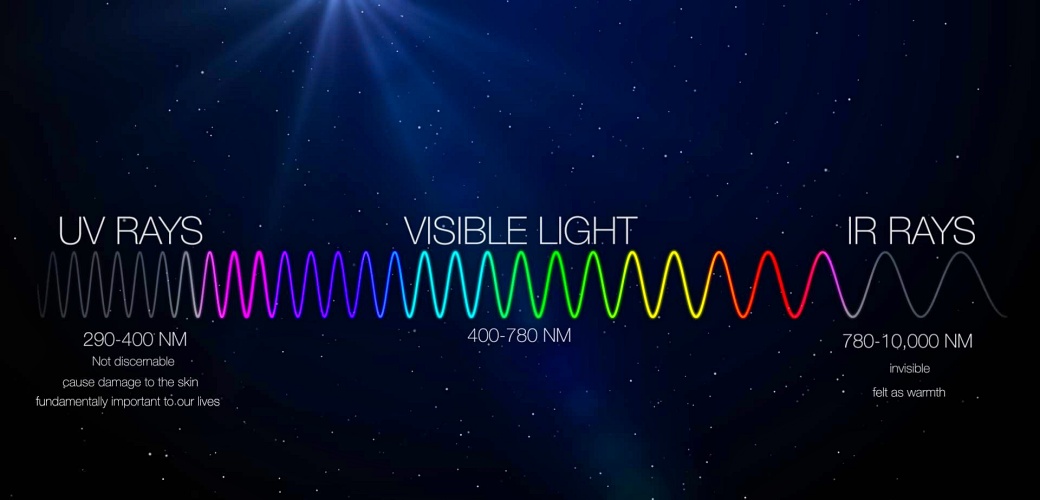
Sunlight
The sun's heat rays
Sunshine puts us in a good mood. There's no doubt about it. And the sun warms us up. This is where IR radiation comes into play. Unlike the UV rays that we often hear about, we can feel it. This is why it is often referred to as heat radiation.
If we briefly examine IR radiation in this article, discuss heat and heat radiation and you come to the conclusion, “Gee! Now we finally know the cause of sunburn”, we will quickly shout out, “Stop!”. Sunburn is caused by the invisible UV rays. IR rays provide heat, that’s true. But their effects on the body are different from sunburned skin.
Hippocrates (460–370 BCE), discussed the effects of the sun and light on people in his treatise “On Airs, Waters and Places”. He wrote that people from the sunnier regions of the world have a more positive attitude and character and are less susceptible to diseases. Sunshine puts us in a good mood. True. A lack of sunshine kills your mood. Also true for many people.
But what exactly was responsible for the sun also providing heat was not to be explored until a long time later. It was Sir Friedrich Wilhelm (William) Herschel, a German-British astronomer and musician, who provided evidence of infrared radiation. He probably wasn’t even considering an invisible cause of heat. The original aim of his experiments was to record or measure the temperature of sunlight.
At the end of the rainbow
Using a prism, he wanted to transfer his results to paper, or rather, to the thermometer. Then came the surprise: The temperature increased where there was no visible light. The German Aerospace Center e.V. (DLR) had a headline ready for the discovery: “At the end of the rainbow.” Invisible but warming infrared radiation had been discovered. It connects directly to visible light. From there, there are subdivisions, which we are familiar with from the UV range of radiation. IR-A (short wave) from 780–1400 nm – IR-B: 1400–3000 nm – IR-C (long wave): 3000–10,000 nm. IR rays are therefore part of the so-called optical rays (ultraviolet – visible light – infrared).
Electromagnetic radiation in the optical range (naturally generated by the sun or also artificially generated) is divided into 3 ranges:
Figures in nanometers
Ultraviolet
UVC: 290 nm >
UVB: 320–290 nm
UVA: 400–320 nm
Visible radiation (light or VIS, visual radiation)
400–780 nm
Infrared
IR-A (short wave): 780–1400 nm
IR-B: 1400–3000 nm
IR-C (long wave): 3000–10000 nm
Infrared radiation, the most important natural source being the sun, accounts for up to 50% of the solar radiation that hits our Earth. The Earth, in turn, emits infrared radiation after the sun has heated it. By the way, this is what all objects and bodies do, provided that they have a sufficient natural temperature of at least warmer than minus 273 degrees Celsius, which is absolute zero.
IR rays are not visible but perceptible. Our body absorbs their energy and the molecules start to dance around. The result of this is heat. In other words, this is exactly the reaction we associate with the sun—it warms us. Although much of the absorption of infrared radiation (IR-B and IR-C) takes place on the surface of the skin (epidermis), the heat seems to manage to find its way effortlessly to the core of the body. Short-wave IR-A penetrates the subcutaneous skin. In addition, IR-A also makes its way into the retina of the eyes.
Measure fever with an infrared thermometer
Incidentally, water is responsible for how deeply IR rays can penetrate the skin. The human body consists of almost two thirds water, which means the IR absorption capacity of the water determines how far the infrared radiation can go under the skin. With short-wave IR-A rays, the absorption capacity is low, allowing the short-wave rays to penetrate deeply. The longer the waves, the greater the IR absorption in the skin.
Recognizing differences
Snakes have so-called pit organs. These sensory organs allows the animals to perceive and locate the smallest temperature differences.
Infrared rays are used in medicine and industry. Muscular and back problems can be treated using IR due to its warming effect, for example, in so-called infrared cabins or using special IR lamps. However, a doctor should assess whether such a treatment is suitable for you and recommend suitable applications.
One example of a technical application is the use of thermal imaging cameras. These cameras, also known as infrared cameras, give bodies that radiate heat a different color so they can be identified. Using night vision devices, you can detect people in complete darkness, for example. Modern clinical thermometers also use IR for contactless body temperature measurement.
Skin damage also caused by IR?
But back to the sun’s IR rays. Even though the warmth is good for you, it is also true that too much of it is too much. In addition to sunstroke, there are other forms of heat damage that can stress and injure the body. Read about what can happen if you absorb too much IR radiation in our article about the body’s reactions here.
Although IR radiation does not cause sunburn, we still need to protect ourselves from it. In this case, however, we can't rely on the usual sunscreens and creams for protection. It’s more about protection through avoidance. Wear clothing, a hat, stay in the shade or a cool room, and make sure you drink plenty. It is not a good idea to walk around in the strong midday sun at lunchtime unless you have to. And take care of your eyes as well. Looking directly at the sun can be harmful, especially due to the enormous brightness in the visible range and also due to infrared radiation.
We have pointed out the dangers of UV radiation for the skin many times. For years, researchers and scientists have also been studying the effects of infrared on the skin. Some research suggests that short-wave IR-A rays penetrating deep into the skin can cause changes, free radical formation and oxidative stress. The result is damaged cells and increased collagen degradation. However, the mechanism of action seems to be different compared to UV. Instead of UV filters, antioxidants are required to minimize damage.
And just like with UV protection: Enjoy the sun, but watch how much time you spend in it and your exposure.

